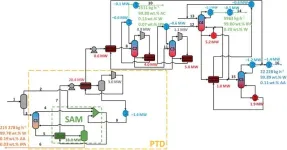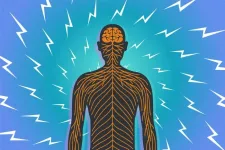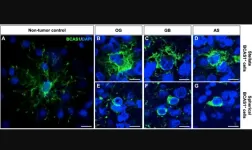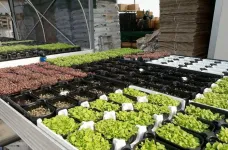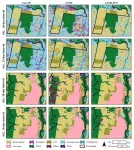(Press-News.org) Artificial Intelligence (AI) can predict whether adult patients with brain cancer will survive more than eight months after receiving radiotherapy treatment.
The use of the AI to successfully predict patient outcomes would allow clinicians to be better informed for planning the next stage of treatment and refer patients to potentially life-saving treatment quicker.
This is the first use of AI to predict short-term and long-term survivors within eight-months of radiotherapy.
The paper published recently in Neuro-Oncology shows how researchers from King’s College London created a deep learning model to allow them to more reliably and accurately predict outcomes for patients with adult primary brain cancer.
Glioblastoma is a difficult to treat cancer with just one in four patients surviving more than one year after diagnosis. The researchers applied deep learning – a type of AI - to predict whether glioblastoma patients would survive the eight months after receiving radiotherapy. Eight months is typically the time taken to complete a typical course of routine chemotherapy that usually follows radiotherapy.
Currently, patients are regularly and routinely scanned to see if the chemotherapy is working. But this means that some patients have ineffective chemotherapy which wouldn’t save their life and suffer through harmful side effects.
Instead, by giving an instantaneous and accurate prediction from one routine MRI scan, the AI allows doctors to identify patients who would not benefit from chemotherapy to try a different treatment or start an experimental treatment in a clinical trial.
Dr Thomas Booth, Reader in Neuroimaging at King’s College London and a Neurology Consultant at King’s College Hospital NHS Foundation Trust, said: “This study was motivated by a clinically-attuned and critical research question regarding aggressive brain tumours, and delivered by leveraging cutting edge artificial intelligence. Whilst less common than other cancers, the devastation is disproportionate with a two-year survival rate of 18%.”
Alysha Chelliah, PhD researcher from King’s College London, said: “We applied deep learning to predict whether glioblastoma patients will survive the first eight months after completing radiotherapy. The AI model showed improved performances when first trained to detect abnormalities on 10,000s of brain MRIs. This approach is intended to improve the ability to identify patients who require early second-line treatment or clinical trial enrolment, compared to those showing initial treatment response.”
Researchers trained the AI on a dataset of 10,000s of scans from all types of patients with brain cancer.
Dr Thomas Booth said: “Feedback from all patients and clinicians at the start of the study meant that we wanted to address the unmet need of improving outcomes of the large proportion of patients undergoing modified treatment – usually a shorter course and lower dose of radiotherapy if chemotherapy is not effective - as well as the minority of patients who can tolerate "optimal" treatment. Almost all previous research considers only the latter group of patients.
“We also side-stepped a thorny issue: after radiotherapy, follow-up brain scan findings are often non-specific and oncologists cannot be certain whether a treatment is working or failing.
“Instead of trying to grapple with interpreting each and every non-specific follow-up brain scan, we simply looked at one routine scan after radiotherapy and gave an accurate prediction using artificial intelligence to answer a simple question: which patients will not survive the next 8 months? The AI was able to give us an immediate and accurate prediction which means clinicians can empower patients to make choices about their treatment.”
Dr Booth added: “We would be delighted if the cancer research community now uses our artificial intelligence tool to see improved outcomes for patients who won’t benefit from the usual course of chemotherapy.”
Commenting on how the work of Dr Booth and his team at King’s College London supported people-first brain tumour research as advocated for by the charity brainstrust, Dr Helen Bulbeck, Director of Services and Policy at brainstrust said:
“This is exciting and fundamental research for people living with a glioblastoma, for two reasons. At its simplest level it demonstrates how AI can be used for patient benefit. More importantly however, it empowers patients and their caregivers to make choices about the clinical pathway and gives control back at a time when so much control has been lost. Patients will be able to make informed decisions about treatment choices and will be able to plan how they want to spend the time they have left so that they can live their best possible day, every day.”
Dr Michele Afif, CEO at The Brain Tumour Charity added: “The use of AI to evaluate and predict response to radiotherapy at a much earlier point in a patient's treatment for glioblastoma is a hugely important step in tackling this notoriously difficult to treat disease.
At The Brain Tumour Charity, we welcome this important advance which could lead to more informed discussions at an early enough point in a patient’s treatment to consider meaningful alternatives, such as clinical trials.
We look forward to seeing how this exciting research progresses as it is validated for wider use as a tool to improve care for those diagnosed with a brain tumour.”
The study involved a collaboration of 11 neuro-oncology centres from across the UK.
END
AI can predict brain cancer patients’ survival
2024-01-31
ELSE PRESS RELEASES FROM THIS DATE:
Fermentation revolution? Trash becomes treasure as bio-waste yields valuable acetone and isopropanol
2024-01-31
In a major stride towards sustainable industrial fermentation, a team of researchers at Delft University of Technology (TU Delft) in The Netherlands, has unveiled pioneering advancements in the purification of isopropanol and acetone from the fermentation of waste gases. The study, published in SCI's Journal of Chemical Technology and Biotechnology, introduces novel processes that promise to elevate the efficiency and viability of large-scale production.
Isopropanol and acetone have a combined global market of $10 billion. Both chemicals are important industry solvents and isopropanol ...
The hottest catalog of the year: the most comprehensive list of slow-building solar flares yet
2024-01-31
Solar flares occur when magnetic energy builds up in the Sun’s atmosphere and is released as electromagnetic radiation. Lasting anywhere from a few minutes to a few hours, flares usually reach temperatures around 10 million degrees Kelvin. Because of their intense electromagnetic energy, solar flares can cause disruptions in radio communications, Earth-orbiting satellites and even result in blackouts.
Although flares have been classified based on the amount of energy they emit at their peak, there has not been significant study into differentiating ...
Researchers uncover potential non-opioid treatment for chronic pain
2024-01-31
Among the most difficult types of pain to alleviate is neuropathic pain, pain that is usually caused by damage to nerves in various body tissues, including skin, muscle and joints. It can cause patients to suffer feelings like electric shocks, tingling, burning or stabbing. Diabetes, multiple sclerosis, chemotherapy drugs, injuries and amputations have all been associated with neuropathic pain, which is often chronic, sometimes unrelenting and affects millions of people worldwide. Many of the available pain medications are only moderately effective at treating this type of pain and often come with serious ...
John Theurer Cancer Center (JTCC) physician co-authors clinical research on innovative oral leukemia therapy
2024-01-31
Researchers at Hackensack Meridian’s John Theurer Cancer Center (JTCC), are part of a published Phase 3 study reporting on the equivalent safety and effectiveness in the oral treatment of blood cancers–such as myelodysplastic syndrome and/or chronic myelomonocytic leukemia–to its previously inpatient, intravenous treatment counterparts.
John Theurer Cancer Center is part of the NCI-designated Lombardi Comprehensive Cancer Center at Georgetown University.
Dr. James K. McCloskey, M.D., led JTCC’s ...
UC Irvine scientists make breakthrough in quantum materials research
2024-01-31
Irvine, Calif., Jan. 31, 2024 — Researchers at the University of California, Irvine and Los Alamos National Laboratory, publishing in the latest issue of Nature Communications, describe the discovery of a new method that transforms everyday materials like glass into materials scientists can use to make quantum computers.
“The materials we made are substances that exhibit unique electrical or quantum properties because of their specific atomic shapes or structures,” said Luis A. Jauregui, professor of physics & astronomy ...
BCAS1 defines a heterogeneous cell population in diffuse glioma patients
2024-01-31
“[...] this is the first study describing a BCAS1+ cell population in a large cohort of diffuse glioma patients.”
BUFFALO, NY- January 31, 2024 – A new research paper was published in Oncotarget's Volume 15 on January 24, 2024, entitled, “BCAS1 defines a heterogeneous cell population in diffuse gliomas.”
Oligodendrocyte precursor markers have become of great interest to identify new diagnostic and therapeutic targets for diffuse gliomas, since state-of-the-art studies point towards immature oligodendrocytes as a possible source of gliomagenesis. Brain enriched myelin associated ...
Microgreens made to order: Italian scientists have tailored iodine and potassium content of radishes, peas, rocket and chard
2024-01-31
In a significant development for personalised nutrition, researchers in Italy have cultivated microgreens with bespoke nutritional profiles to serve individual dietary requirements.
The study, published in the Journal of the Science of Food and Agriculture (doi: 10.1002/jsfa.13222), provides a blueprint for the soilless cultivation of nutritionally enriched plants in a commercial greenhouse setting.
Co-authors Massimiliano D’Imperio and Francesco Serio, both at the Institute of Sciences of Food Production (ISPA) National Council ...
How to make bright quantum dots even brighter
2024-01-31
Quantum dots are a kind of artificial atom: just a few nanometres in size and made of semiconductor materials, they can emit light of a specific colour or even single photons, which is important for quantum technologies. The discoverers and pioneers of the commercial production of quantum dots were awarded the Nobel Prize in Chemistry in 2023. In recent years, quantum dots made of perovskites have attracted particular attention. Perovskites belong to a class of materials that have a similar structure to the mineral perovskite ...
Method combines artificial intelligence and satellite imagery to map crop-livestock integration systems
2024-01-31
Crop-livestock integration (CLI) systems combine the growing of crops in rotation or consortium, especially grain crops such as soybeans, corn and sorghum, and forage plants used to feed cattle and pigs, with the raising of livestock, typically beef cattle. The crops provide most of the cash income, while the livestock has food available during the dry season and facilitates seed management. CLI improves soil fertility, raises yields and helps rehabilitate degraded areas while reducing the use of pesticides, mitigating the risk of erosion and the seasonality of production, and lowering ...
Pedestrian injuries from falls versus motor vehicle collisions: are we lacking critical policy and interventions?
2024-01-31
January 31, 2024—Using Emergency Medical Services (EMS) data, researchers at Columbia University Mailman School of Public Health compared the national burden of pedestrian injuries from motor vehicles to that of pedestrian falls occurring on streets and sidewalks and found that the probability of a pedestrian suffering a severe injury is higher for motor vehicle collisions as compared to falls. Yet, the public health burden of the number of pedestrians injured from a fall – severe or otherwise - is significantly higher compared to the number of pedestrians injured by a motor ...
